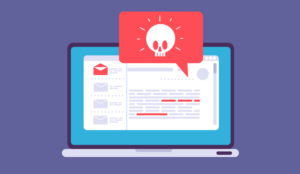83 percent of companies will face a data breach at some point. Given that contact centres often handle sensitive consumer data like credit card details, social security numbers, and general contact information, it’s no surprise that they become frequent targets.
With new security challenges emerging from both outside and inside of your organization, it’s essential that you understand how to detect and avoid the most prominent threats.
What Constitutes a Call Centre Security Threat?
A security threat means that someone attempts to steal or otherwise compromise private information hosted by a contact centre. These threats can be either internal or external.
For example, a cybercriminal can attempt to access your system from the outside. Alternatively, it can be a disgruntled employee abusing their access to steal customer data.
Given that call centres often work with heavily regulated industries like finance and healthcare, these threats are a major concern for leadership. With the average cost of a data breach coming in at $9.44 million, any security lapse could be fatal.
What Are the Biggest Call Centre Security Threats?
Whether it’s a cyberattack from outside the organization or an internal system failure, a security threat can lead to a breach of regulatory compliance.
The first step to safeguarding your organization against these threats is understanding their origins. Failure to do so could lead to legal and financial repercussions, as well as significant reputational damage.
Cybersecurity Threats
A number of different threats fall under the broad umbrella of cybersecurity. Some of the main areas of concern for call centres include:
TDoS Attacks:
A telephony denial of service (TDoS) attack is when the attacker compromises a telephony system by bombarding it with a high volume of calls to prevent genuine callers from getting through.
Hacking:
Call centres handle large volumes of information, with call recordings and transcripts containing the kind of sensitive data that hackers can use for financial gain.
Phishing:
This attack happens when hackers deceive people into sharing sensitive information via social engineering.
According to a recent FBI report, it is the most common cybercrime in the United States. Phishing attacks target individual call centre employees, hoping to lure agents into sharing sensitive information.
IoT Attacks:
The Internet of Things (IoT) refers to the network of physical objects capable of connecting to the internet and exchanging data.
With the use of such devices increasing, cybercriminals have more access points to attack. For call centres, the increase in remote and hybrid work following the pandemic has further exposed call centres to such attacks via unsecured IoT devices that lack sufficient security.
Ransomware:
Ransomware attacks threaten publishing or block access to sensitive data unless the target pays a ransom. In the first half of 2022 alone, there were nearly 250 million ransomware attacks worldwide. The nature of these attacks is particularly concerning for contact centre leaders.
Insider Data Theft
The nature of the call centre industry dictates that employees often have access to sensitive customer data.
There are ways to limit this access and protect the consumer, as we will discuss shortly, but it’s difficult to guarantee trust and protect information effectively. Bribes, threats, or even carelessness on the agent’s behalf can lead to the theft and release of this data.
With an average call centre attrition rate of 42 percent, high turnover in the call centre industry opens up the possibility of a disgruntled or untrustworthy employee stealing information.
Faulty, Outdated or Pirated Systems
Failure to monitor and update the programs and systems used within the call centre can expose an organization to threats. Software updates often include new security components, so make sure to implement them.
Furthermore, employees who lack technical skills or don’t fully understand possible security threats may put the organization at risk by installing pirated programs on work devices.
Compliance Breaches
Given the volume of processed consumer data, it’s no surprise that the contact centre industry is subject to significant regulatory and legal mandates.
PCI standards maintain security for payment processing, the Do Not Call registry protects the public from unwanted calls, and HIPAA safeguards health data—these are just some of the regulations call centres must abide by.
A breach in any of these areas or even something as straightforward as failing to acquire consent for call recording could lead to legal action. With agents responsible for following these rules and human error playing a part in 82 percent of data breaches, ensuring call centre staff compliance is essential.
Lack of Threat Awareness
Maybe the most significant human threat to call centre security is a simple lack of awareness. Without proper education on cybercrime, security threats, and personal responsibility, employees may, unintentionally, expose their company to an attack.
If you fail to provide adequate training, agents could end up sharing sensitive information, clicking on a suspicious link, or even accidentally disabling security software. Perhaps the most powerful antivirus software is knowledge.
How Can You Mitigate Call Centre Security Risks?
Cybercriminals are always developing new strategies, so it’s essential that you stay one step ahead by refining your own cybersecurity systems and processes.
Be proactive, not reactive. Don’t wait until something goes wrong to start taking your digital security seriously. Pre-empt the threats, and you can avoid the damaging repercussions of a breach.
Let’s take a look at what you can do to mitigate the most common call centre security risks.
Provide Appropriate Security Training
Security training isn’t just for the IT team; it’s for everyone in the organization. As a call centre leader, your agents are your first line of defense, so it’s essential that you empower them to take responsibility for their own cybersecurity.
Your onboarding and training processes should provide guidance on common security threats like phishing and ransomware, industry-specific items like PCI and HIPAA, and your company’s security policies.
For example, a module on common social engineering tactics, with real-world examples, could help agents to spot potential threats.
If you have access to QA tools like scorecards, you can automatically monitor whether or not your agents are staying compliant during customer interactions.
Create a Call Centre Security Policy
When it comes to security, you don’t want to leave room for interpretation. A strong security policy with clear procedures for everything from passwords to encryption to consumer privacy will leave agents with no doubt about their role in the organization’s safety.
You may also want to define separate guidelines for remote call centre workers, as they could require additional guidance on staying safe outside the office.
These procedures, and the overall policy, should be included in both onboarding and training to ensure that all employees are aware of them.
Additionally, it would help if you worked to refine this security policy continuously, making it a key part of your call centre audit process
Review Employee Privileges
While agents require access to certain information to carry out their duties, it’s important that you don’t grant blanket permissions to everyone within the organization.
A more role-based access approach can significantly limit the risk of a data breach and help you respond quickly to potential threats.
By granting permissions based on need, job title, seniority, and other factors, you’re only entrusting sensitive information to those who absolutely require it as part of their role in the call centre.
This minimizes the chances of an internal attack and allows you to quickly revoke access in the event of a breach.
Deploy Digital Security Measures
There are a number of specific digital security measures you can apply to mitigate threats. Using multi-factor authentication or single sign-on, for example, can minimize the chances of a breach by better securing network access, limiting password fatigue, and improving threat detection capabilities.
Stronger password management is also a simple way to improve data security. Never use default passwords, and ensure a system is in place to facilitate regular employee password updates.
On top of these sign-in and password-related measures, you should be able to regularly back up and encrypt your data, protecting your organization from cyberattacks.
Keep Your Software and Systems up to Date
Phishing, IoT attacks, ransomware—all of these tactics are becoming more complex by the day. Ensuring your software and systems are up to date is essential to safeguarding your call centre.
While frequent updates can be inconvenient, they’re essential for addressing vulnerabilities and staying ahead of hackers.
Sometimes, you may even need to switch to new tools. Perhaps you’ve carried out a call centre audit and discovered that your old security software is no longer fit for purpose. In this case, be sure to remove your legacy systems and revoke access for former employees.
Use Automation
90 percent of cyberattacks target individual employees rather than IT systems or organizational infrastructure.
Given that call centre agents frequently have access to sensitive consumer data, removing the human element from the equation is one way to limit the chances of a breach.
Using automation tools, you can protect your team from these targeted attacks and minimize the chances of human error.
Research shows that organizations using AI and automation have, on average, a 74-day shorter breach lifecycle than those that don’t.
Cultivate a Positive Work Environment
In 2022, the frequency of insider-led cybersecurity incidents rose by 44 percent. Call centre agents are privy to customer information during calls, and they can also copy data from recordings or transcripts after the interaction, opening up a number of avenues for potential insider threats.
By cultivating a positive work environment and vetting new recruits to ensure they are reputable and trustworthy, you can minimize the chances of a malicious internal attack.
Healthy company culture can also lower churn, limiting the possibility of an ex-employee seeking retribution.
Final Thoughts
When dealing with sensitive customer information and clients from highly regulated industries like healthcare and finance, potential security threats can come from a number of sources.
Whether it’s cybercriminals attempting to target individuals with phishing schemes or outdated software leading to a data leak, you must remain vigilant.
Thankfully, with strong policies, targeted training, and the use of automation, you can mitigate these security risks.
A robust QA platform can provide you with the foundation for stronger cybersecurity. You can design custom training modules within an integrated LMS and track regulatory adherence with flexible scorecards and in-depth analytics tools.
This blog post has been re-published by kind permission of Scorebuddy – View the Original Article
For more information about Scorebuddy - visit the Scorebuddy Website
Call Centre Helper is not responsible for the content of these guest blog posts. The opinions expressed in this article are those of the author, and do not necessarily reflect those of Call Centre Helper.
Author: Scorebuddy
Published On: 30th Mar 2023
Read more about - Guest Blogs, Scorebuddy






 Scorebuddy is quality assurance solution for scoring customer service calls, emails and web chat. It is a dedicated, stand-alone staff scoring system based in the cloud, requiring no integration.
Scorebuddy is quality assurance solution for scoring customer service calls, emails and web chat. It is a dedicated, stand-alone staff scoring system based in the cloud, requiring no integration. 





























